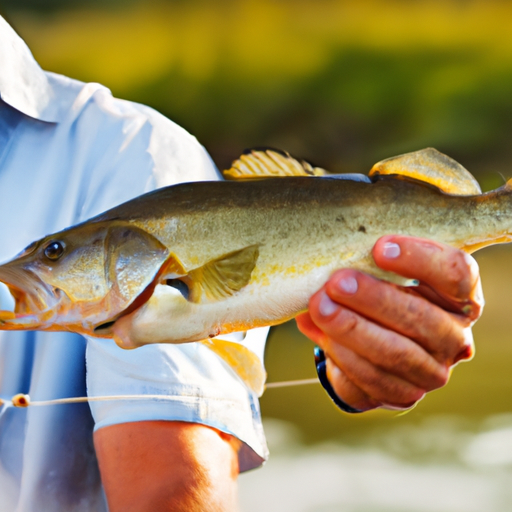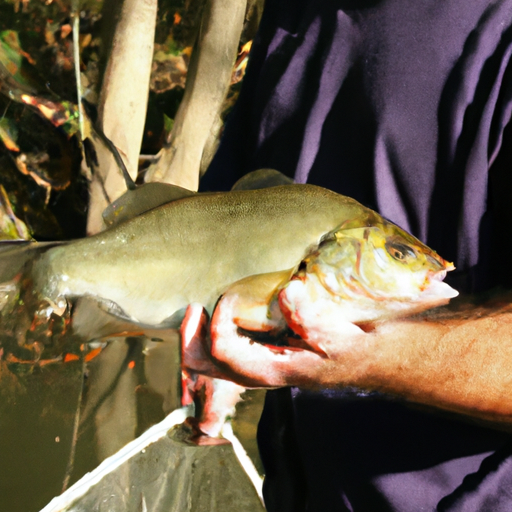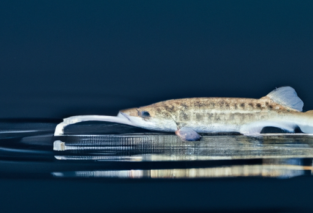Imagine you’re standing knee-deep in the tranquil waters of a serene lake, sunlight dancing on the surface. You cast your line, eagerly waiting for that exhilarating tug. But what happens when you finally reel in your catch? Your heart races with excitement, yet tinged with uncertainty. How do you handle the fish in a way that ensures their safety? Fear not, dear novice angler, for the solution comes in the form of “How To Safely Handle Fish As A Novice Angler.” In this comprehensive guide, you’ll learn the essential techniques and practices to preserve the well-being of these aquatic creatures, allowing you to fully enjoy the thrill of fishing without compromising their welfare.

Choosing the right equipment
Selecting a suitable fishing rod
When it comes to choosing a fishing rod, it’s important to consider the type of fishing you’ll be doing and the fish species you’ll be targeting. A suitable fishing rod should be able to handle the weight of your bait or lure, as well as the weight of the fish you’re aiming to catch. The length of the rod is also crucial, with longer rods being better suited for casting longer distances and shorter rods providing more control in confined spaces. Additionally, consider the material the rod is made of. Graphite and fiberglass rods are popular choices due to their durability and flexibility.
Choosing the right fishing line
Selecting the appropriate fishing line is essential for a successful fishing trip. The fishing line serves as a crucial link between you and the fish, so it’s vital to choose the right type and thickness. Monofilament, fluorocarbon, and braided lines are commonly used options. Monofilament lines are versatile and relatively affordable, while fluorocarbon lines are more invisible in the water and less likely to be detected by fish. Braided lines offer excellent strength and sensitivity. Consider the water conditions and the size of the fish you’re targeting when choosing the thickness of your fishing line.
Picking the appropriate bait or lure
The choice of bait or lure depends on the type of fish you’re aiming to catch and the fishing technique you’ll be using. Live bait, such as worms or minnows, is often enticing to a wide range of fish species. Artificial lures, on the other hand, come in various shapes, sizes, and colors, with each designed to mimic a particular type of prey. It’s essential to research the fish species you’re targeting and their preferred food sources to make an informed decision. Experiment with different baits and lures to find what works best for your fishing style and the fish you’re hoping to catch.
Using the correct fishing hooks
Choosing the right fishing hooks can significantly impact your fishing success. Hooks come in different sizes, designs, and materials. Make sure to select a size appropriate for the fish you’ll be targeting, considering their mouth size and weight. The gap size between the hook’s point and shank is also crucial to ensure a secure hookset. For catch and release fishing, barbless fishing hooks are highly recommended as they minimize damage to the fish and make hook removal easier. Additionally, ensure that your hooks are in good condition, with no signs of rust or damage, to maximize their effectiveness.
Preparing for a fishing trip
Checking local fishing regulations
Before heading out on your fishing adventure, take the time to familiarize yourself with the local fishing regulations. Fishing laws and regulations can vary from one location to another, so it’s essential to understand what is allowed and what is prohibited. Familiarize yourself with catch limits, size restrictions, fishing seasons, and any special rules for specific bodies of water. Knowing and following these regulations not only helps to preserve fish populations but also ensures you stay on the right side of the law.
Researching the target fish species
To increase your chances of a successful fishing trip, it’s crucial to research the fish species you’re targeting. Learn about their habitats, feeding habits, and preferred fishing techniques. Understanding the behavior of your target fish can help you choose the most appropriate bait or lure, as well as determine the best time of day and location to fish. In addition to online resources, local anglers, fishing guides, and fishing forums can provide valuable insights and tips specific to the fish species you’re pursuing.
Gathering the necessary fishing gear
Before embarking on your fishing trip, ensure you have all the necessary fishing gear. Besides your fishing rod, reel, and line, make sure you have a variety of hooks, sinkers, and swivels in different sizes. Don’t forget to pack extra fishing line and leaders in case of breakages or snags. Other essential fishing gear includes a tackle box or bag to keep your gear organized, fishing pliers or forceps for hook removal, a fishing knife for cutting bait or line, and a fishing net for landing larger fish. Being prepared with the right gear will save you time and frustration while out on the water.
Preparing safety equipment
Safety should always be a top priority when heading out on a fishing trip. Ensure you have the necessary safety equipment, such as a life jacket or personal flotation device, especially if you’ll be fishing from a boat or in deeper water. Sunscreen, a hat, and polarized sunglasses are essential to protect yourself from the sun’s harmful rays. Insect repellent can also come in handy to ward off pesky bugs in fishing areas with high insect activity. Packing a basic first aid kit is advisable in case of any minor scrapes or injuries that may occur while handling fish or navigating rough terrain. Be prepared, and prioritize safety at all times.
Understanding fish anatomy
Identifying the various fish body parts
Understanding fish anatomy is essential for handling fish properly. Some key fish body parts to familiarize yourself with include the mouth, gills, eyes, fins, and scales. The mouth is where the fish takes in food and where fishing hooks are usually attached. The gills are responsible for extracting oxygen from the water and should be handled with care to avoid damage. The eyes provide vision and are delicate, so take caution when handling fish near their eyes. Fish fins aid in maneuvering and balance, and fish scales provide protection. Knowing and respecting these body parts will help minimize harm to the fish during handling.
Learning the fish’s sensory organs
Fish rely on their sensory organs to survive and thrive in their environment. Familiarize yourself with their sensory organs, such as the lateral line system, which detects changes in water pressure and vibrations. The olfactory system allows fish to detect odors in the water, while the inner ear helps them maintain balance and orientation. By understanding how fish perceive their surroundings, you can modify your fishing techniques to increase your chances of success. For example, using scented baits or lures that appeal to their sense of smell can be highly effective in attracting fish.
Understanding fish behaviors
Knowledge of fish behaviors can greatly enhance your fishing experience. Fish exhibit a variety of behaviors, such as feeding patterns, mating rituals, and territoriality. Understanding these behaviors can help you predict where fish are likely to be located and how they will respond to different baits or lures. For example, predatory fish tend to be more active during certain times of the day, while bottom-dwelling fish may require specific bait presentations. Observing fish behavior and adapting your fishing strategy accordingly can significantly increase your chances of a successful catch.
Knowing proper catch and release techniques
Understanding the importance of catch and release
Catch and release fishing is an essential conservation practice that ensures the future sustainability of fish populations. It involves catching a fish and then immediately releasing it back into the water, unharmed. This practice allows fish to reproduce and contribute to the overall health of the ecosystem. By understanding the importance of catch and release, novice anglers can actively contribute to the preservation of fish populations for future generations to enjoy.
Using barbless fishing hooks
When practicing catch and release fishing, it is highly recommended to use barbless fishing hooks. Barbless hooks make hook removal quicker and easier, reducing the chances of inflicting unnecessary harm to the fish. The absence of a barb also helps minimize tissue damage, allowing for a smoother and less traumatic release. Barbless hooks are widely available and have become increasingly popular among anglers who prioritize the well-being of the fish they catch.
Minimizing fish handling time
To minimize stress and potential harm to the fish, it is crucial to minimize fish handling time. The longer a fish is out of the water, the greater the risk of injury or exhaustion. When handling a fish, be quick but gentle. Use proper fish handling techniques, such as wetting your hands, holding the fish firmly but not squeezing too tightly, and avoiding excessive flipping or flopping. By reducing fish handling time, you maximize the chances of a successful release and ensure the fish’s well-being.
Reviving exhausted fish before release
If you catch a fish that appears exhausted or lethargic, it’s important to revive it before releasing it back into the water. Hold the fish gently in an upright position, allowing water to flow through its gills. This helps the fish recover and replenish its oxygen levels. Avoid forcefully shaking or jerking the fish, as this may cause additional stress or harm. Once the fish begins to show signs of regained strength, gently release it back into the water and observe as it swims away.

Handling fish with wet hands
Moistening your hands before handling fish
When handling fish, it is crucial to keep their slimy outer coating, known as the slime coat, intact. The slime coat serves as protection against infections and parasites. To minimize damage to the slime coat, moisten your hands with water before handling fish. Wet hands help reduce the amount of slime that is lost during the handling process. Avoid using lotions, sunscreen, or any other chemical substances on your hands, as these can be harmful to fish.
Holding the fish gently but firmly
When holding a fish, it’s essential to strike a balance between grip and gentleness. Hold the fish securely but avoid excessive force that may harm or injure the fish. Support the body of the fish with your hand, keeping it horizontal to minimize stress on the fish’s internal organs. Never grasp or squeeze the fish too tightly, as this can cause injury or even death. By holding the fish gently but firmly, you ensure its safety and reduce the risk of causing unnecessary harm.
Avoiding excessive pressure
When handling fish, it’s important to avoid exerting excessive pressure, especially on soft or delicate areas. Refrain from applying excessive force to the fish’s abdomen, as this can cause internal injuries. Be mindful of the fish’s fins, which are delicate and can be easily damaged if mishandled. Handle fish with care, keeping in mind their fragility, and ensure they are supported properly to minimize any potential harm.
Protecting the fish’s slime coat
The slime coat of a fish is vital for its overall health and well-being. To protect this slimy layer, handle fish as minimally as possible. Avoid dragging or sliding the fish over rough surfaces, as this can damage or remove the slime coat. If you need to lay the fish down temporarily, use a damp landing mat or cradle to protect its delicate slime coat. By taking precautions to preserve the slime coat, you help ensure the fish’s long-term health and resilience.
Using fishing nets properly
Selecting an appropriate fishing net
When it comes to choosing a fishing net, it’s important to select one that is suitable for the fish species you’ll be targeting. Consider the net’s size, mesh material, and handle length. Nets with smaller mesh sizes are ideal for smaller fish as they can prevent them from getting entangled or slipping through the net. For larger fish, choose a net with a sturdier handle and a larger hoop size. Additionally, opt for nets made of fish-friendly materials that minimize the risk of tangling or injuring the fish.
Avoiding damage to fish scales and fins
When using a fishing net to land a fish, take care to avoid damaging their scales and fins. Avoid forcefully scooping or thrashing the net around, as this can cause abrasions or tears in the fish’s delicate skin. Gently guide the fish into the net, allowing it to swim in naturally. Ensure that the fish is fully contained within the net before lifting it out of the water. By handling the fishing net with care, you minimize the risk of harming the fish’s external structures.
Using a proper landing technique
Proper landing technique is crucial to safely and effectively land a fish using a fishing net. As the fish gets closer to the net, position the net in the water, beyond the fish. Slowly guide the fish towards the net, allowing it to swim in naturally. Ensure that the fish is completely inside the net before lifting it out of the water. Avoid jerking or lifting the fish too forcefully, as this can lead to injuries. By practicing a proper landing technique, you can successfully and safely land your catch.
Releasing the fish from the net safely
Once you have safely landed the fish in the net, it’s important to release it back into the water without causing any harm. Hold the net over the water, allowing the fish to remain supported by the water’s buoyancy. Gently and carefully remove the fish from the net, making sure the fish is fully submerged in the water. Gradually tilt the net to allow the fish to swim out unimpeded. By releasing the fish from the net safely, you provide it with the best chance of a successful transition back into its natural environment.

Avoiding injury to the fish
Avoiding excessive squeezing or dropping
To minimize harm to fish, it’s important to avoid excessive squeezing or dropping. Excessive squeezing or holding the fish too tightly can cause internal injuries or damage delicate structures. Handle the fish gently but firmly, supporting its body properly to minimize stress and harm. Avoid dropping or forcefully throwing the fish back into the water, as this can cause injuries upon impact. By treating each fish with care and respect, you ensure their well-being and the long-term sustainability of fish populations.
Minimizing stress and harm to fish
Handling fish with care and minimizing stress is essential to reducing harm. Excessive stress caused by mishandling or rough treatment can be detrimental to a fish’s health and survival. Keep the fish in the water as much as possible to reduce stress and allow it to breathe properly. Avoid subjecting fish to prolonged air exposure, as it can lead to oxygen deprivation and even death. By adopting proper fish handling techniques and minimizing stress, you contribute to the overall well-being of the fish.
Handling toothy or spiky fish
Some fish species have teeth or spines that require extra caution when handling. To avoid injury, use fish handling tools such as fish grips or specialized pliers. These tools allow you to control the fish’s movement without putting your fingers at risk. If you need to handle a toothy or spiky fish manually, take extra care to protect yourself. Wet your hands before handling the fish, use a firm grip while avoiding the sharp areas, and handle the fish with confidence and control.
Using fish handling tools for safety
Fish handling tools can be valuable assets when it comes to safely handling fish. Fish grips or lip grippers are a popular choice for managing toothy or spiky fish. They provide a secure hold on the fish’s mouth or jaw, allowing you to control their movement without putting your fingers at risk. Specialized pliers or forceps are also useful for hook removal, especially when dealing with deep-hooked fish. Fish handling tools not only protect the fish from unnecessary harm but also ensure your safety as an angler.
Knowing how to unhook fish
Using proper fishing pliers or forceps
Proper fishing pliers or forceps are essential tools for safely removing hooks from a fish’s mouth. Choose pliers or forceps specifically designed for fishing, as they provide a secure grip and minimize the risk of hook slippage. Ensure your pliers or forceps have a sharp cutting edge for trimming hook points if necessary. Using the proper tools makes hook removal quicker, safer, and less stressful for the fish.
Removing the hook carefully and quickly
When removing the hook from a fish’s mouth, it’s important to do so carefully and quickly. Ensure you have a firm grip on the hook with your pliers or forceps, and gently and steadily apply pressure in the opposite direction of the hook’s barb. If the fish has swallowed the hook deeply, it may be necessary to cut the line and leave the hook in place. Quick and efficient hook removal minimizes stress and potential injury to the fish.
Dislodging deeply embedded hooks
Sometimes, hooks may become deeply embedded in a fish’s mouth, making removal more challenging. Attempting to forcefully yank or pull the hook can cause severe harm or injury. In such cases, it is best to leave the deep-hooked fish undisturbed and consult a professional or experienced angler for assistance. Remember, the health and well-being of the fish take precedence over the retrieval of the hook.
Resolving hooking incidents
Occasionally, hooking incidents can occur where you accidentally hook yourself or another person. Remain calm and carefully assess the situation. If the hook is only lightly embedded, it may be possible to carefully back it out using pliers or forceps. However, if the hook is deeply embedded or surrounded by sensitive structures, seek medical assistance immediately. Do not attempt to forcibly remove the hook yourself, as this can worsen the injury.

Minimizing harm to the fish’s mouth and gills
Avoiding damage to the fish’s mouth
To minimize harm to a fish’s mouth, it’s important to use proper fish handling techniques. Avoid overly forceful hooksets, as they can cause injuries to the fish’s mouth and jaw. When handling the fish, avoid touching or pressuring the soft tissues inside the mouth. If possible, use fish grips or pliers to remove the hook and minimize contact with the fish’s mouth. By prioritizing the fish’s well-being, you contribute to its overall health and survival.
Handling lip-hooked fish
Lip-hooked fish are those in which the hook is primarily caught in the lip or the corner of the mouth. These fish are generally easier to unhook with minimal harm. Use pliers or forceps to carefully remove the hook, ensuring a gentle and quick motion. Take care not to excessively twist or tug at the hook, as this can cause unnecessary injuries. By handling lip-hooked fish with care, you ensure their safe release and minimize harm to their fragile mouth tissue.
Using appropriate fish grips
Fish grips, also known as lip grippers, are versatile tools for handling fish, especially larger or toothy species. They provide a secure hold on the fish’s lip or jaw, allowing for safe extraction of hooks without putting your fingers at risk. Choose fish grips with a locking mechanism to ensure a strong and secure hold. When using fish grips, take care not to apply excessive pressure that may cause injury to the fish’s mouth or jaw.
Preventing gill damage during hook removal
When removing hooks from a fish’s mouth, it’s crucial to avoid damaging the delicate gills. The gills are responsible for extracting oxygen from the water, and any harm to them can have severe consequences for the fish’s survival. When using pliers or forceps to remove the hook, take care to avoid contact with the gills. Ensure a firm grip on the hook and maintain a steady and controlled motion to minimize the risk of gill damage.
Proper fish transfer and transport
Using fish-friendly landing mats or cradles
When landing a fish, it’s important to ensure a comfortable and safe surface for them. Fish-friendly landing mats or cradles provide a cushioned and supportive area for the fish to lie on during handling. Landing mats or cradles also help protect the fish’s delicate slime coat by avoiding contact with rough surfaces. Choose a landing mat or cradle made of fish-friendly materials and ensure it is large enough to accommodate the size of the fish you’re targeting.
Supporting the fish’s weight correctly
Supporting the fish’s weight correctly is essential to minimize stress and potential harm. Larger fish, in particular, may require extra support to prevent injury. When lifting a fish, cradle it with both hands, supporting the weight evenly and ensuring the fish is horizontal. Avoid hanging or holding the fish by its jaw or gills, as this can cause severe damage. By correctly supporting the fish’s weight, you minimize the risk of injuries and help maintain the fish’s well-being.
Transporting fish in aerated containers
If you plan on keeping a fish to be transported or consumed later, it’s important to ensure their well-being during this process. Use a suitable aerated container or livewell to keep the fish in a controlled and oxygenated environment. Ensure the container is spacious enough for the fish to move and that the water quality is maintained at suitable levels. Avoid overcrowding the container, as this can cause additional stress and harm to the fish.
Releasing fish gently back into the water
After catching a fish, it’s important to release it gently and safely back into the water. Avoid simply tossing or dropping the fish, as this can cause injuries upon impact. Instead, hold the fish close to the water’s surface and gently release it, allowing it to swim away naturally. Avoid forcefully pushing or shoving the fish, as this can disrupt its equilibrium and potentially harm its internal organs. By releasing the fish gently, you ensure its smooth transition back into its natural habitat.
In conclusion, as a novice angler, it’s important to prioritize the well-being and safety of the fish you catch. By choosing the right equipment, preparing adequately for your fishing trip, understanding fish anatomy and behaviors, and using proper fish handling techniques, you can minimize stress and harm to the fish. Respect the importance of catch and release fishing and adopt practices that promote the long-term sustainability of fish populations. By treating each fish with care and respect, you contribute to the preservation of our precious aquatic ecosystems for future generations to enjoy.






